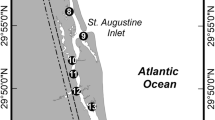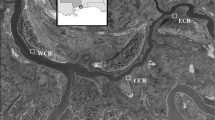Abstract
Nekton was sampled in five marshes along the salinity gradient of the Schelde River. The utilisation of three different habitats (large and small creek, marsh pond) by fish and macrocrustacean species was compared among the five sampling sites. In the larger channels fyke nets were deployed to capture fish and macrocrustaceans leaving the marsh at ebb while block nets were set in smaller intertidal creeks. Fish traps passively sampled fish and shrimp in the marsh ponds. The tidal freshwater marsh had a species poor fauna and only a low number of fish was caught. Besides some freshwater species (Alburnoides bipunctatus, Carassius carassius) the European eel, Anguilla anguilla was still present. The four other marshes had a similar community structure although Platichthys flesus was absent from the euhaline area. Among fish species, dominance of Dicentrarchus labrax, Platichthys flesus and Pomatoschistus microps was observed. Carcinus maenas and Palaemonetes varians were the most abundant macrocrustacean species in every marsh. Between the large and small intertidal creeks there was no difference in nekton species composition. The main species used both habitats. Marsh ponds were utilized intensively only by two species, Pomatoschistus microps and Palaemonetes varians in every marsh.
Similar content being viewed by others
References
Aprahamian, M. W. & D. C. Barr, 1985. The growth, abundance and diet of O-group sea bass, Dicentrarchus labrax, from the Severn Estuary. Journal of Marine Biological Association of the United Kingdom 65: 169–180.
Bray, J. R. & J. T. Curtis, 1957. An ordination of the upland forest communities of southern Wisconsin. Ecological Monographs 27: 325–349.
Bulger, A. J., 1984. A daily rhythm in heat tolerance in the salt marsh fish Fundulus heteroclitus. Journal of Experimental Zoology 230: 11–16.
Cattrijsse, A., E. S. Makwaia, H. R. Dankwa, O. Hamerlynck & M. A. Hemminga, 1994. Nekton communities of an intertidal creek of a European estuarine brackish marsh.Marine Ecological Progress Series 109: 195–220.
Cochran, R. E. & L. E. Burnett, 1996. Respiratory responses of the salt marsh animals, Fundulus heteroclitus, Leiostomus xanthurus, and Palaemonetes pugio to environmental hypoxia and hypercapnia and to the organophosphate pesticide, azinphosmethil. Journal of Experimental Marine Biology and Ecology 195: 125–144.
Costa, M. J. & H. N. Cabral, 1999. Changes in the Tagus nursery function for commercial fish species: some perspectives for management. Aquatic Ecology 33: 287–292.
Costa, M., F. Catarino & A. Bettencourt, 2001. The role of salt marshes in the Mira estuary (Portugal). Wetlands Ecology and Management 9: 121–134.
Desmond, J. S., J. B. Zedler & G. D. Williams, 2000. Fish use of tidal creek habitats in two southern California salt marshes. Ecological Engineering 14: 233–252.
De Veen, J. F., R. Boddeke & K. H. Postuma, 1979. Tien jaar kinder-kamer-opnames in Nederland: I. Het Zeeuws estuarium (in Dutch). Visserij 32: 3–32.
Drake, P. & A. M. Arias, 1991. Composition and seasonal fluctuations of the ichthyoplankton community in a shallow tidal channel of Cadiz Bay (S.W. Spain). Journal of Fish Biology 39: 245–263.
Frid, C. L. J., 1988. The marine fauna of the north Norfolk salt marshes and their ecology. Transactions of the Norfolk and Norwich Naturalists Society 28: 46–50.
Frid, C. L. J. & James R., 1989. The marine invertebrate fauna of a British coastal salt marsh. Holarctic Ecology 12: 9–15.
Gunter, G., 1961. Some relations of estuarine organisms to salinity. Limnology and Oceanography 6: 182–190.
Halpin, P. M., 2000. Habitat use by an intertidal salt-marsh fish: trade-offs between predation and growth. Marine Ecological Progress Series 198: 203–214.
Holbrook, S. J. & R. J. Schmitt, 1988. The combined effects of predation risk and food reward on patch selection. Ecology 69: 123–134.
Hostens, K., 2003. The demersal fish and macro-invertebrate assemblages of the Westerschelde and Oosterschelde estuaries (Southern Bight of the North Sea). University of Ghent, Gent, 164 pp.
Kneib, R. T., 1997. The role of tidal marshes in the ecology of estuarine nekton. Oceanography and Marine Biology 35: 163–220.
Kneib, R. T. & S. L. Wagner, 1994. Nekton use of vegetated marsh habitats at different stages of tidal inundation. Marine Ecological Progress Series 106: 227–238.
Laffaille, P., S. Brosse, E. Feunteun, A. Baisez & J. C. Lefeuvre, 1998. Role of fish communities in particulate organic matter fluxes between salt marshes and coastal marine waters in the Mont Saint-Michel Bay. Hydrobiologia 373/374: 121–133.
Laffaille, P., E. Feunteun & J. C. Lefeuvre, 2000. Composition of fish communities in a European macrotidal salt marsh (the Mont Saint-Michel Bay, France). Estuarine, Coastal and Shelf Science 51: 429–438.
Layman, C. A., D. E. Smith & J. D. Herold, 2000. Seasonally varying importance of abiotic and biotic factors in marsh-pond fish communities. Marine Ecological Progress Series 207: 155–169.
Lefeuvre, J. C., V. Bouchard, E. Feunteun, S. Grare, P. Laffaille & A. Radureau, 2000. European salt marshes diversity and functioning: The case study of the Mont Saint-Michel Bay, France. Wetlands, Ecology and Management 8: 147–161.
Maes, J., A. Taillieu, P. Van Damme & F. Ollevier, 1997. The composition of the fish and crustacean community of the Zeeschelde Estuary (Belgium). Belgian Journal of Zoology 127 (1): 47–55.
Marshall, S. & M. Elliott, 1998. Environmental influences on fish assemblages of the Humber estuary, UK. Estuarine, Coastal and Shelf Science 46: 175–184.
Mathieson, S., A. Cattrijsse, M. J. Costa, P. Drake, M. Elliott, J. Gardner & J. Marchand, 2000. Fish assemblages of European tidal marshes: a comparison based on species, families and functional guilds. Marine Ecological Progress Series 204: 225–242
McIvor, C. C. & L. P. Rozas, 1996. Direct nekton use of intertidal salt marsh habitat and linkages with adjacent habitats: a review from the southeastern United States. In Nordstorm, K. F. & C. T. Roman (eds), Estuarine Shores: Evolution, Environments, and Human Alteration. John Wiley and Sons, West Sussex: 311–334.
Power, M. E., 1984. Depth distribution of armored catfish: predatior-induced resource avoidance? Ecology 65: 523–528.
Raffaelli, D., H. Richner, R. Summer & S. Northcott, 1990. Tidal migrations in the flounder. Marine Behavioral Physiology 16: 249–260.
Rakocinski, C. F., D. M. Baltz & J. W. Fleeger, 1992. Correspondence between environmental gradients and the community structure of marsh-edge fishes in a Louisiana estuary. Marine Ecological Progress Series 80: 135–148
Reed, D. J., 1993. Hydrology of temperate wetlands. Progress in Physical Geography 17: 20–31.
Ross, S. W. & S. P. Epperly, 1985. Utilization of shallow estuarine nursery areas by fishes in Pamlico Sound and adjacent tributaries North Carolina. In Yanez-Arancibia, A. (eds), Fish Community Ecology in Estuaries and Coastal Lagoons: Towards an Ecosystem Integration. Universidad National Autonoma de Mexico, Mexico City: 207–232.
Rozas, L. P. & W. E. Odum, 1987. Use of tidal freshwater marshes by fish and macrofaunal crustaceans along a marsh creek-order gradient. Estuaries 10: 36–43.
Rozas, L. P. & D. J. Reed, 1993. Nekton use of marsh-surface habitats in Louisiana (U.S.A.) deltaic salt marshes undergoing submergence. Marine Ecological Progress Series 96: 147–157.
Rozas, L. P. & R. J. Zimmerman, 2000. Small-scale patterns of nekton use among marsh and adjacent shallow nonvegetated areas of the Galveston Bay Esturay, Texas (U.S.A.). Marine Ecological Progress Series 193: 217–239.
Smith, K. J. & K. W. Able, 1994. Salt-marsh tide pools as winter refuges for the mummichog, Fundulus heteroclitus, in New Jersey. Estuaries 18: 226–234.
Talbot, C. W. & K. W. Able, 1984. Composition and distribution of larval fishes in New Jersey high marshes. Estuaries 7: 434–443.
Weinstein, M. P., S. L. Weiss & M. F. Walters, 1980. Multiple determinants of community structure in shallow marsh habitats, Cape Fear River estuary, North Carolina. Marine Ecological Progress Series 58: 227–243.
Werner, E. E., J. F. Gilliam, D. J. Hall & G. G. Mittelbach, 1983. An experiment test of the effects of predation risk on habitat use in fish. Ecology 64: 1540–1548.
Williams, G. D. & J. B. Zedler, 1999. Fish assemblage composition in constructed and natural tidal marshes of San Diego Bay: Relative influence of channel morphology and restoration history. Estuaries 22: 702–716.
Zedler, J. B., G. D. Williams & J. S. Desmond, 1997. Wetland mitigation: can fishes distinguish between natural and constructed wetlands? Fisheries 22: 26–28.
Author information
Authors and Affiliations
Rights and permissions
About this article
Cite this article
Hampel, H., Cattrijsse, A. & Mees, J. Changes in marsh nekton communities along the salinity gradient of the Schelde river, Belgium and The Netherlands. Hydrobiologia 515, 137–146 (2004). https://doi.org/10.1023/B:HYDR.0000027325.16156.6c
Issue Date:
DOI: https://doi.org/10.1023/B:HYDR.0000027325.16156.6c




